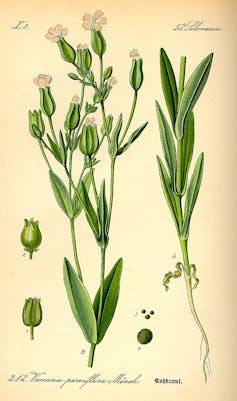"Ear seeding" is having a moment on TikTok and Instagram . One video of someone's experience of ear seeding has been "liked" more than half a million times . Supermodel Naomi Campbell is among celebrities reported to have tried it .
Author
- Jon Wardle
Professor of Public Health, Southern Cross University
This wellness trend is said to do wonders for fatigue, stress, pain, puffiness, poor posture, sleep problems and more.
But what is ear seeding? And does it actually work?
What is it?
Ear seeding - also known as ear needling, ear acupuncture or auriculotherapy - refers to treatment that stimulates specific points on the ear.
It's related to acupuncture or acupressure, and is most commonly thought of today as a traditional Chinese medicine treatment .

The theory behind ear seeding is that by stimulating different points of the ear (known as acupoints), you can influence particular organs or body parts.
Although ear seeding is sometimes called ear acupuncture, needles are rarely used.
Instead the main form uses small balls attached with tiny sticking plasters to specific points on the ear. These are supposed to gently stimulate the acupoints over hours or days.
Ear seeds made from 24-carat gold are being peddled online. But traditionally ear seeding uses the very small, hard seeds of the Vaccaria plant.
How old is ear seeding?
Although auriculotherapy has now become a recognised branch of traditional Chinese medicine, the history of ear seeding as we see it today is as much French as it is Chinese.
And although much is made of its long history of use, ear seeding as it is practised today is a surprisingly recent invention.
In the 1950s French neurologist Paul Nogier observed what happened when folk healers stimulated the ears of a number of his patients. They said they had improved symptoms of sciatica (a condition caused by a compressed nerve, leading to back and leg pain).
Nogier then spent much of the 1950s charting how the ear related to the rest of the body .
This work eventually caught the attention of the Chinese military, which investigated, refined, and amended the chart to better fit Chinese medicine philosophy into the officially recognised form of auriculotherapy we see today.
Since then, TikTok influencers have brought ear seeding to a new audience. But they're not its only high-profile promoters.
NATO armed forces , including the US military , have been using ear seeding for pain relief.
But does it work?
Despite the heightened interest in ear seeding, there is relatively little research on it. Much of the existing research is in relatively small trials that are largely inconclusive.
This means that even where positive studies exist, the evidence should be thought of more as promising than compelling.
And where evidence does exist, it suggests ear seeding works best as a supportive treatment with other therapies, rather than a standalone treatment.
Some research is also suggesting some effect of ear seeding on body systems and processes that influence brain activity and inflammation, but again many of these studies are small and inconclusive.
The areas where the research appears most promising is for reducing pain , reducing anxiety and improving sleep .
Are there safety issues, side effects or concerns?
Generally ear seeding is a relatively safe treatment , as the ear seeds don't interact with medications and don't pierce the skin.
Not surprisingly, the major side effect relates to pain, sensitivity or irritation of the ear from the ear seed itself.
And while there may be an emerging evidence base for ear seeding in some conditions, this should generally be on the advice of a health practitioner.
This is partly because many symptoms for which ear seeding is being promoted on social media - such as " face puffiness " - may have underlying causes that need to be addressed with other therapies or treatments.
It's also easy to stimulate the wrong acupoint in the ear. So you might not get the result you're after, or have no result at all.
What's the key message?
Ear seeding is a relatively recent therapy that draws on some aspects of traditional medicine. There does seem to be some evidence it may be useful in some conditions. But there is still not enough evidence to offer definitive recommendations to use it.
Although it is relatively safe, its main danger comes from promotion of unfounded health claims that may convince you to use the therapy in place of more effective treatment when it's needed.
While people are increasingly turning to avenues such as TikTok for health advice, it is always advisable to consult a trained health professional on health matters. This is preferably one who isn't posting a link to buy the product they're recommending.
![]()
Jon Wardle is Professor of Public Health, Foundation Director of the National Centre for Naturopathic Medicine and the Maurice Blackmore Chair of Naturopathic Medicine at Southern Cross University, which undertakes training and research in integrative health therapies. He has received funding from multiple foundations and agencies to conduct research on integrative health therapies, including the National Health and Medical Research Council, Defence Health Foundation and Medical Research Future Fund. He is convenor of the Public Health Association of Australia special interest group in complementary medicine.






